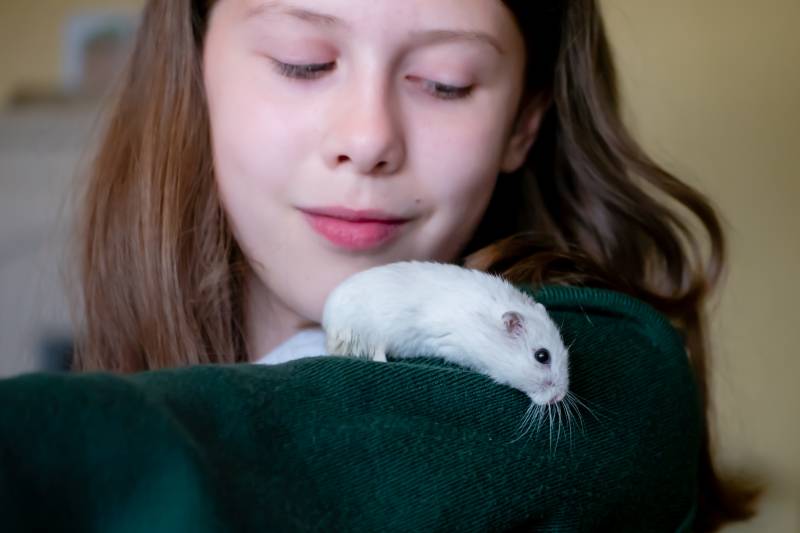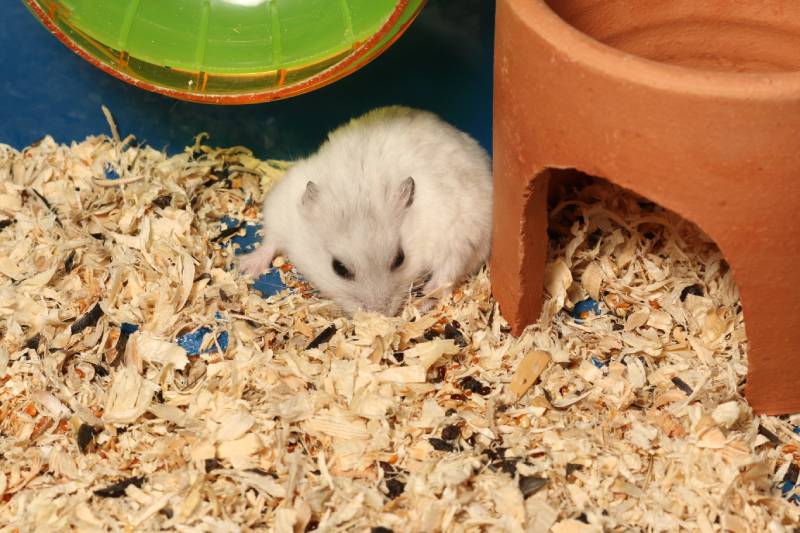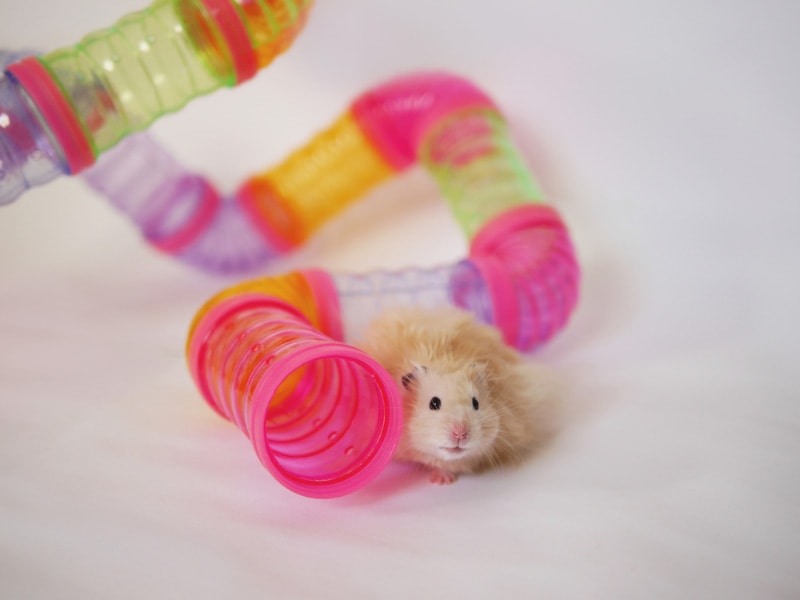Winter White Dwarf Hamster: Pictures, Temperament & Traits (Vet-Verified Info)

Updated on

Click to Skip Ahead
The Winter White dwarf hamster (Phodopus sungorus), often referred to as the “Siberian dwarf hamster” or the “Djungarian dwarf hamster,” is a small, domesticated species. They are frequently mistaken for the Campbell’s dwarf hamster, but there are a few minor distinctions. They are one of the most popular species available.
In this article, we’ll talk about how to care for them, as well as their curious personality and color-changing appearance. You can get all the information you need about caring for your Winter White in this post, which should help you succeed in being the best hamster parent you can be.
| Size: | 3–4 inches |
| Weight: | 19 to 45 grams (0.67 to 1.59 oz), weight decreases drastically in winter |
| Lifespan: | 1.5–3 years (average), record is 3.9 years |
| Similar To: | Campbell dwarf hamster |
| Suitable for: | First-timer hamster owners, older children, and owners looking for a short-term commitment |
| Temperament: | Sociable, gentle, adaptable, curious, friendly, easy to tame |
Although Winter White Dwarf hamsters might be challenging to manage due to their small size and agility, they are typically gentle and receptive to handling when kept as pets.
With a few minor exceptions, they resemble Campbell’s hamsters in appearance. They are less woolly than the Campbell’s hamster. Another unique and fascinating trait is their ability to change their coat color to white in the winter (in the wild) to blend in with the snow. Overall, Winter White Dwarf hamsters make lovely pets.
Winter White Dwarf Characteristics

How Much Do These Hamsters Cost?
Along with Campbell’s hamster and the larger Syrians, the Winter White is a common hamster found at pet stores. However, you might need to use your investigative skills to distinguish between the various breeds of hamsters because not all pet retailers identify their hamsters accurately.
You can get your hamster from a trustworthy breeder or knowledgeable rescue organization to ensure it is a Winter White Dwarf. Expect to pay between $15 and $25, though this can change depending on the hamster’s age and other factors. Breeders typically have more young animals available than rescue organizations.
Local exotic animal veterinarians can frequently direct you to a reliable breeder or rescue organization. In addition, many breeders are members of organizations that go to pet expos where you may learn about and even buy hamsters.
The leading monthly expenses for your Winter White Dwarf hamster will typically be the food and bedding. Expect to spend between $20 and $40 on average, depending on what you choose, the size of your enclosure, and the number of hamsters you own. Toys and other items also need replacing when they’re chewed up. Additionally, be sure to include emergency and routine veterinary care in your budget.

Temperament & Intelligence of the Winter White Dwarf Hamster
Even for people new to hamster ownership, Winter White Dwarf hamsters can make excellent pets that are comparatively easy to care for. They are often friendly and less likely to bite than other species since they are more tolerant of being handled. They may still bite if startled or handled too tightly.
Winter White Dwarf hamsters are gentle and laid-back like Syrian hamsters but not quite as territorial. They are not afraid of people, and their fear is overcome by their curiosity. The Winter White Dwarf hamster is known to be one of the most tamable compared to other species.
They are also known to be lively and love to play, and they require a lot of space. Although the hamsters are nocturnal, they may occasionally be active during the day. For the most part, they are calm pets, but if you put their enclosure close to your bed, their midnight activity may keep you awake.
They are a relatively social species, and when introduced at a young age, they can be kept in small groups or pairs of the same sex.
Finally, remember that hamsters all enjoy chewing incessantly! This behavior should be taken into consideration while purchasing toys and cages.
Do These Hamsters Make Good Pets?👪
Absolutely! Winter White hamsters are fun to own, easy to tame, and inexpensive to maintain as pets. It doesn’t get much better than a dwarf hamster if you’re a first-time pet owner or looking for another fun hamster to care for. Another significant advantage of the Winter White is that you can choose to keep one hamster alone or a group of Winter Whites in a larger cage – however, these should be same-sex litter mates that are introduced at a very young age.
Winter Whites make wonderful pets for children. However, as they are fairly sensitive and cannot be dropped from any significant height, they are generally better for older kids. Additionally, these hamsters can be a little trickier to handle because they move faster than Syrians, but you shouldn’t encounter any significant issues as long as you keep an eye on any kids who engage with the hamster.
It is also essential to take into account that they are most active at sunset and at night because they are nocturnal and sleep during the day, but on the plus side, this works nicely with the schedules of most people.

Does This Hamster Get Along With Other Pets?
A Winter White can live alone or share a home with other hamsters of the same sex. However, keeping the Winter White in pairs or groups is not always necessary, as they are fundamentally solitary.
Keeping a mixed-sex pair or group of hamsters requires careful consideration because breeding will occur, and hamster litters can be born every 3 weeks. We advise starting with a solitary hamster if it is your first time taking care of a hamster. Introduce the hamsters when they are young and separate them immediately if you notice any fighting amongst them.
If you have cats and dogs at home, you must be especially careful with your tiny pet. Keep their cage in a separate room, and be sure to keep your other pets away when your hamster is playing outside the enclosure. The scent of a predator can stress hamsters, and therefore, having them share a home with predators such as a rat, cat, dog, or ferret is considered controversial.

Things to Know When Owning a Winter White Dwarf Hamster:
Food & Diet Requirements
One of the most important components of hamster care is establishing a balanced diet. Winter Whites eat fruit, vegetables, seeds, nuts, and insects like all hamsters do, but serving your hamster a variety of food is often the best option.
Choose a commercial dwarf hamster food as your pet’s main nutritional source. Ensure your veterinarian approves it and follow the feeding recommendations on the label and those of your veterinarian. Since they tend to graze, your hamsters should always have hay accessible.
A tiny ceramic bowl can be placed in the enclosure with a full day’s worth of food. After 24 hours, any food that hasn’t been consumed should be thrown out and the bowl refilled. It is ideal to feed your hamster in the evening when they wake up hungry.
You can also provide some additional supplemental foods approved by your veterinarian. Generally, greens, blueberries, apples, cucumbers, and carrots are a few popular options. To prevent them from spoiling, keep fresh food in a separate bowl from the main meal and throw it out after a few hours. Be careful about your hamster’s antics though – they may hoard food into their dens, which you might have to retrieve before it spoils!
Veterinarians advise against feeding your pet hamster a diet high in seeds. Pet hamsters are prone to obesity since seeds are abundant in fat and low in nutrition. Always provide clean, fresh water for your hamster. The ideal water bottle attaches to the enclosure’s side because it is simple to maintain. Nevertheless, until you’re sure your hamster is drinking from the bottle, add a little dish of water. Make sure you replace the water every day.

Enclosure Requirements
When it comes to your hamster’s cage, bigger is usually better since it will serve as the main area for exercise and mental stimulation, so choose the biggest cage you can manage. The standard minimum is 24 inches in length and 12 inches wide. These measurements are equivalent to a 20-gallon aquarium.
The two primary enclosure choices are a wire cage with a plastic base or a glass/plastic aquarium with a safe top and ventilation. Ensure the wire spacing is not too wide for your tiny hamster to easily get through.
Add at least 2 to 3 inches of soft bedding to the bottom of the enclosure, such as aspen shavings or shredded paper free of chemicals and dyes. Wet areas should be removed from it every day, and every week, you should change the bedding completely. Hamsters prefer deeper bedding if possible, as they’re able to burrow when offered such depth.
Include chew toys, a wheel for exercise, and a nest for your hamster to sleep and hide in the cage. Additionally, you can add tubes and other climbing equipment.
Ensure you keep your hamster’s cage out of direct sunlight, and of course, it should also be out of your curious dog or cat’s reach. To keep their internal clock in sync, your hamster should be kept in a place where the lights are turned out around the same time every day.
Additionally, hamsters are particularly sensitive to high-frequency noises. Keep the area around their cages free of flowing water, air conditioners, televisions, and computers.
Exercise & Sleeping Needs
Hamsters are lively and energetic creatures that benefit greatly from daily exercise. Your hamster should be able to get enough physical stimulation to keep them healthy and avoid problems like obesity as long as you offer a spacious enough enclosure with an exercise wheel.
Your hamster can exercise outside of the cage by rolling around in an exercise ball as long as it is secure and safe. Make sure you pick a ball that is the right size for a dwarf hamster, and keep an eye on the hamster whenever they are in the ball. Hamsters also enjoy running through or hiding in tunnels. However, a cardboard toilet roll will work just as well for the little Winter White Dwarf hamster.
Your pet hamster will sleep for around 6 to 8 hours each day, though not all at once. For a secure place to sleep, Winter Whites often build tunnels in the wild, which they also use to reproduce and hide from predators. In the early morning, your hamster will probably still be active since they are winding down from nighttime activity.
Most hamsters will go to sleep in the middle of the morning and periodically wake up throughout the day to use the bathroom, change positions, or if they are startled.

Training
Most of the time, regular handling sessions are all that’s needed to tame a Winter White Dwarf hamster. When your Winter White becomes tame, you’ll be able to pet them whenever you want, and they will begin to enjoy your attention. It is recommended to begin handling your hamster as early as possible.
Never approach a dwarf hamster from above when handling them. Since your hamster will associate grabbing them from above with predatory actions, you should scoop your hamster from below. When handling your hamster, they should never be shaken or squeezed. Handling them should be done in a secure area, low to the ground, so it’s best to sit on the floor. To get your hamster to sit in your hands, try holding a treat in your palms to coerce them.
Give your Winter White room if they hiss or squeak when you try to handle them. When a hamster is scared, they can bite when handled. To avoid any problems, be aware of your pet’s body language. Hamsters only bite as a last resort.
Grooming
Hamsters are typically clean creatures who do a fantastic job of grooming themselves, so they do not need to be bathed or brushed. If something becomes stuck in their fur, you can help them remove it by giving the area a gentle rubdown with a damp cloth if they’ll allow it.
Since a hamster’s teeth constantly grow, give them chewy snacks and toys to help them wear down. They use their nails daily, and most won’t need to have them clipped. You can take your pet to the vet for a nail trimming if they become overgrown.

3 Little-Known Facts About Winter White Dwarf Hamsters
1. Phodopus sungorus Is the Scientific Name for the Winter White Dwarf Hamster.
The Winter White, also often known as the Siberian or Russian hamster, is native to Kazakhstan, Mongolia, Manchuria, and Siberia.
2. Wintertime Causes This Cute Hamster’s Fur to Turn White.
Winter White Dwarf Hamsters have a gray-brown coat color with a dark dorsal stripe for the rest of the year. This shouldn’t be confused with the pearl white variation of this species which is sometimes found in the pet trade; this variation doesn’t change fur color and remains white even throughout the summer.

3. They Are Very Prolific
With exposure to enough light hours, sexually mature females can begin reproducing. Every four days, females go into heat, and on the day they give birth, they can also become pregnant again! If you have a male and a female, you must exercise extreme caution to avoid becoming overrun with baby hamsters.

Final Thoughts
Winter White Dwarf hamsters, also known as Russian dwarf hamsters, are small, friendly hamsters that are relatively easy to care for, generally easier to tame, and more gentle than other species. They typically respond well to being handled and make excellent pets for those who have never owned hamsters before.
They might be challenging for some individuals to handle, such as small kids, due to their small size and ability to get away fast. When introduced at a young age, they are a relatively social species that can be wonderful pets for many.
Featured Image Credit: Kuttelvaserova Stuchelova, Shutterstock










